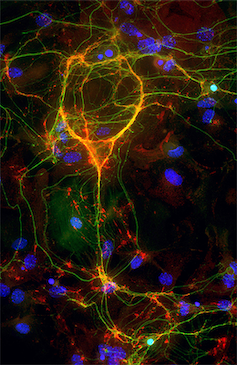Being flexible and learning to adapt when the world changes is something you practice every day. Whether you run into a new construction site and have to reroute your commute or download a new streaming app and have to relearn how to find your favorite show, changing familiar behaviors in response to new situations is an essential skill.
To make these adaptations, your brain changes its activity patterns within a structure called the prefrontal cortex – an area of the brain critical for cognitive functions such as attention, planning and decision-making. But which specific circuits “tell” the prefrontal cortex to update its activity patterns in order to change behavior have been unknown.
The prefrontal cortex of the brain is involved in executive functions like self-control and decision-making.
We are a team of neuroscientists who study how the brain processes information and what happens when this function is impaired. In our newly published research, we discovered a special class of neurons in the prefrontal cortex that may enable flexible behavior and, when they malfunction, may lead to conditions such as schizophrenia and bipolar disorder.
Inhibitory neurons and learning new rules
Inhibitory neurons dampen the activity of other neurons in the brain. Researchers have traditionally assumed they send their electrical and chemical outputs only to nearby neurons. However, we found a particular class of inhibitory neurons in the prefrontal cortex that communicate across long distances to neurons in the opposite hemisphere of the brain.
We wondered whether these long-range inhibitory connections are involved in coordinating changes in activity patterns across the left and right prefrontal cortex. By doing so, they might provide the critical signals that help you change your behavior at the right moment.

Interneurons connect other neurons together.
NICHD/McBain Laboratory via Flickr, CC BY-NC-ND
To test the function of these long-range inhibitory connections, we observed mice performing a task that required them to learn a rule to receive a reward and then later adapt to a new rule in order to continue receiving the reward. In this task, mice dug in bowls to find hidden food. Initially, the smell of garlic or the presence of sand within a bowl might indicate the location of the hidden food. The specific cue associated with the reward would later change, forcing the mice to learn a new rule.
We found that silencing the long-range inhibitory connections between the left and right prefrontal cortex caused the mice to get stuck, or perseverate, on one rule and prevented them from learning new ones. They were unable to change gears and learn that the old cue was now meaningless and the new cue signaled food.
Brain waves and flexible behavior
We also made surprising discoveries about how these long-range inhibitory…


